
Red berries and fruits on small or large trees provide colorful accents in the home garden even in the cold season. Read here which of them you can eat without hesitation.
In a nutshell
- Fruits and berries important distinguishing and identifying feature
- change partial color during formation
- may vary in size and shape
- edible or poisonous depending on the tree species
Table of Contents
- With edible fruits/berries from B – E
- From F – R
- From V – Z
- With poisonous fruits/berries
- frequently asked Questions
With edible fruits/berries from B – E
Blood Plum 'Nigra' (Prunus cerasifera)
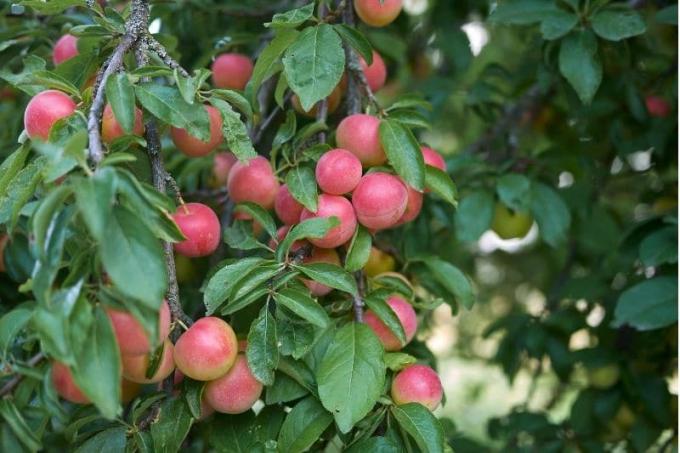
This cherry plum adorns the garden with its abundance of blossoms, leaf and fruit decoration, which not only blends harmoniously into cottage gardens and Japanese gardens.
- Growth: stiffly upright, spherical crown, up to 700 cm
- Foliage: ovate, dark red
- Flowers: pink-white flowers in April
- Fruits: small, dark red, sweet-juicy, Mirabelle-like
- Ripening time: from July
Hawthorn 'Paul's Scarlet' (Crataegus laevigata)
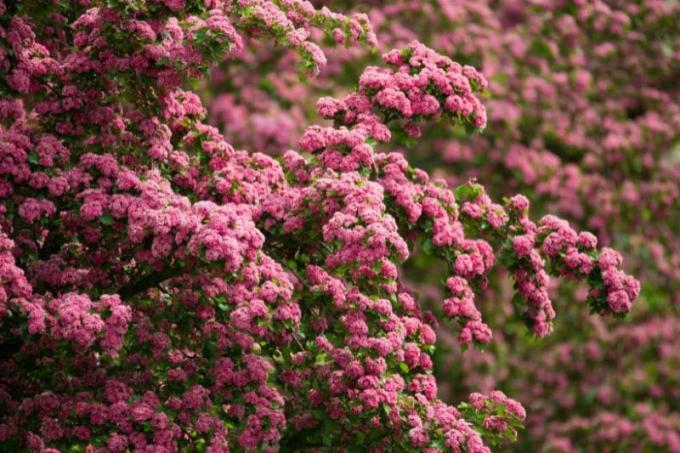
It is one of the most attractive small-crowned flowering trees and cuts a particularly good figure alone, for example as a house tree.
- Habit: broad, conical, loose crown, up to 700 cm
- Foliage: dark green, lobed, serrated
- Flowers: filled upright flower clusters, like roses, May-June
- Fruits: red, oval, mealy, bland in taste
- Ripening time: August-September
Single Hawthorn (Crataegus monogyna)
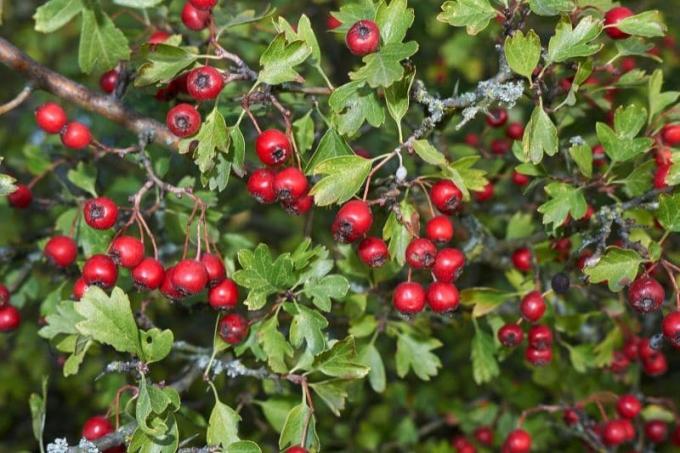
This decorative, flowering ornamental tree is a valuable nesting and bird protection tree and is also used for medicinal purposes.
- Habit: spherical, dense crown, thorns, up to 700 cm
- Foliage: deeply lobed, ovoid, yellow autumn colour
- Flowers: white umbels from May-June
- Fruits: dark red, round to elongated apple fruits
- Maturity: from September for jam production
Tip: Thanks to its dense growth, hawthorn is often used for hedges.
From F – R
Pear 'Ballerina' (Amelanchier laevis)
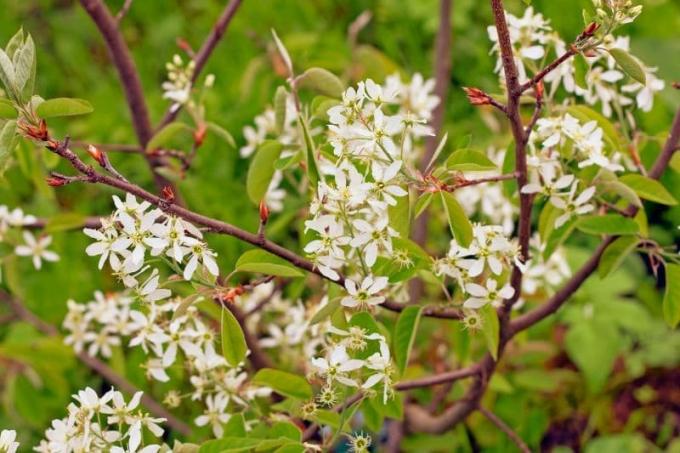
This gorgeous woody plant delights year-round, from flowering to nibble-inducing fruit to crimson fall foliage.
- Growth: upright, arching, overhanging, funnel-shaped crown, up to 600 cm
- Foliage: dark green, oval to rounded, bronze-colored shoots
- Flowers: large white, star-shaped flower clusters
- fruits: small, red, later purple-black
- Ripening time: July to August, black when fully ripe
Common Whitebeam (Sorbus aria)

It grows as a tree or shrub with red berries and can reach an impressive age of up to 200 years. Its berries used to be dried and used as a substitute for flour.
- Growth: even, wide crown, up to 1500 cm high
- Foliage: oval, irregularly serrate margin
- Flowers: creamy white umbrella panicles between May and June
- Fruits: egg-shaped red apples, hardly any taste
- Maturity: wait for the first frost
cornel (Cornusmas)
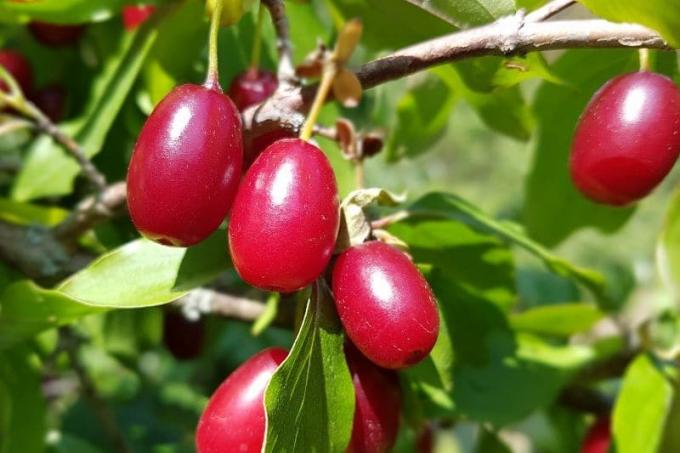
Also as a yellow one dogwood The well-known cornel is a visual highlight with its unusual blossom and bright red fruits.
- Habit: upright, sprawling small tree or large shrub, up to 800 cm
- Foliage: ovate, elliptic, yellow-orange in autumn
- Flowers: yellow umbels from March-April
- Fruits: small, oval, bright red drupes
- Ripening time: August-September, fruity and sour
Tip: The darker the fruit, the sweeter its taste.
Red flowering strawberry tree 'Rubra' (Arbutus unedo)
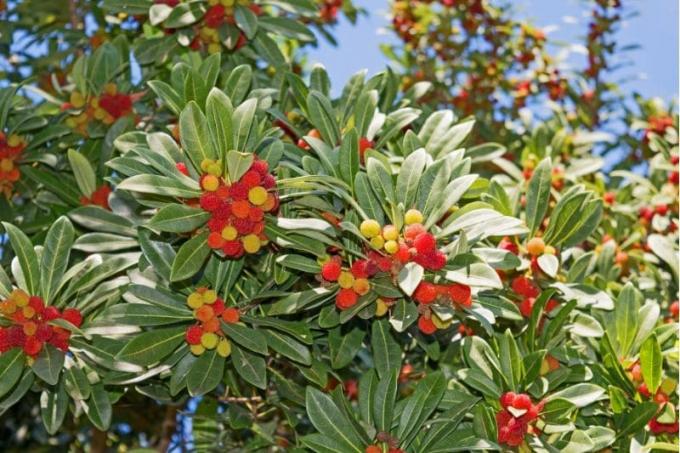
The red berries of this tree are vaguely reminiscent of strawberries, but are not related to them. But this attractive exotic has even more to offer.
- Habit: bushy small tree or large shrub, up to 300 cm
- Foliage: evergreen, sawn
- Flowers: deep pink to red panicles in winter
- Fruits: round, first yellow, later red, similar to lychee
- Ripening time: fruits red when ripe, more suitable for further processing
A notice: There is no specific harvest time, because this plant bears flowers and fruits at the same time.
From V – Z
rowanberry (Sorbus aucuparia)

With its picturesque growth, the decorative foliage and the bright red fruits, the rowanberry catches the eye from afar.
- Growth: Small tree with a light crown, up to 1200 cm
- Foliage: rich green, pinnate, yellow-orange autumn colour
- Flowers: white, slightly fragrant panicles, end of May-June
- Fruits: small red apple fruits
- Ripening time: after the first frost until October
bird cherry (Prunus avium)
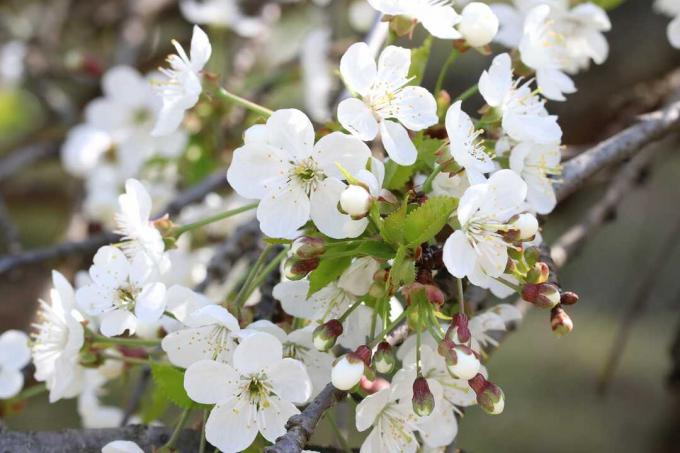
She is the progenitor of all sweet cherries and impresses with its abundance of flowers as well as the small, sweet and somewhat tart fruits.
- Growth: loose foliage, heavily branched, up to 3000 cm high
- Foliage: roughly toothed, elongate oval
- Flowers: white umbels of flowers from April-May
- Fruits: globose black-red drupes
- Ripening period: late June-July
A notice: A special feature of the bird cherry are the horizontal cracks in the bark, so-called cork wart bands.
Ornamental apple 'Evereste' (penalty)

It presents itself as a profusely flowering tree with decorative blossoms and fruits. It is also very resistant to diseases such as scab, fire blight and mildew.
- Growth: loose, upright, pyramidal, overhanging, up to 400 cm
- Foliage: dark green, ovate, three-lobed, toothed
- Flowers: pink-white bowl-shaped flowers, buds red
- Fruits: small, bright orange-red
- Ripening time: from October to November
With poisonous fruits/berries
European holly (Ilex aquifolium)

It is the oldest tree species in Europe and known to many garden owners as a berry and decorative leaf plant that can grow up to 300 years old.
- Habit: initially narrowly conical, later rounded crown, up to 100 cm
- Foliage: glossy green, thorny, toothed
- Flowers: white, inconspicuous, May-June
- Fruits: red berry-like drupes in November
Common Yew (taxus baccata)
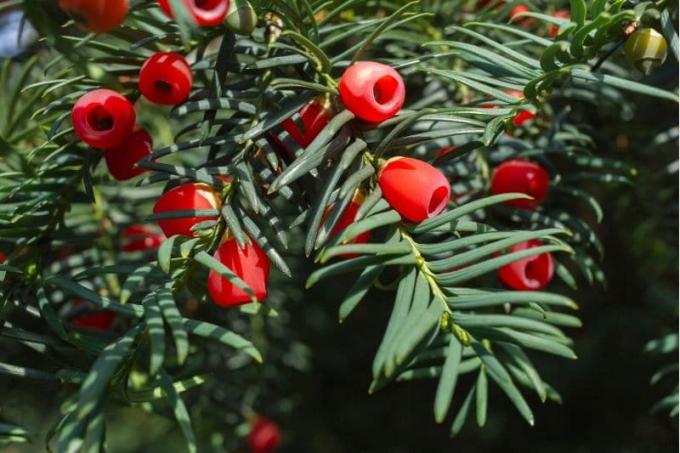
The yew is a versatile coniferous tree that changes its appearance, for example that of its crown, with increasing age.
- Habit: upright, multi-stemmed tree or large shrub, up to 1500 cm
- Foliage: evergreen, soft needles
- Flowers: March to April, inconspicuous
- Fruits: extraordinary light red berries, September/October
Cucumber Magnolia (Magnolia acuminata)
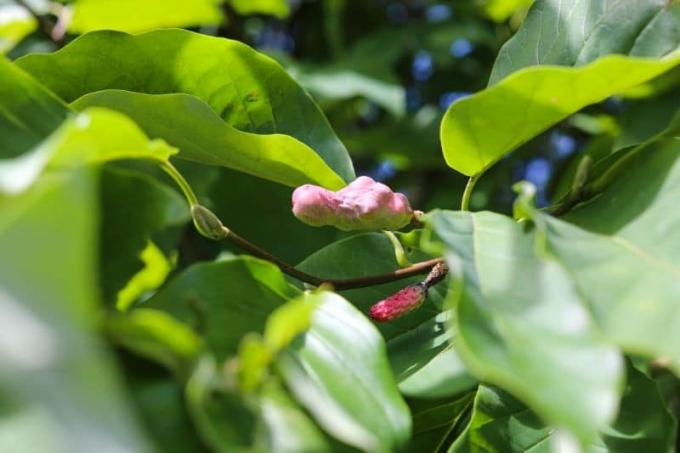
With their extremely attractive flowers belong magnolias undoubtedly one of the most beautiful flowering trees, as does the cucumber magnolia.
- Growth: upright, bushy, up to 2000 cm
- Foliage: Fresh green, underside of leaf a little lighter
- Flowers: greenish-yellow, fragrant flowers from June-July
- Fruits: cucumber-shaped, green, red in autumn
frequently asked Questions
With an appropriate cover or wrapping made of fleece, it can tolerate temperatures down to minus 15 degrees. If it is in a bucket, it is better to overwinter it in a frost-free area.
Raw consumption is not recommended. Even if rowan berries are not poisonous, a few cultivated varieties contain bitter-tasting parasorbic acid. This can lead to discomfort if larger amounts are consumed. When heated, this substance is converted into harmless sorbic acid. As a result, it is better to boil them for at least half an hour and then process them into delicious jam, jelly, juice or vinegar.
The needles and seeds are the most dangerous. In the worst case, poisoning can lead to death. The only thing non-toxic is the berries' red, fleshy outer covering that surrounds the black seeds.



